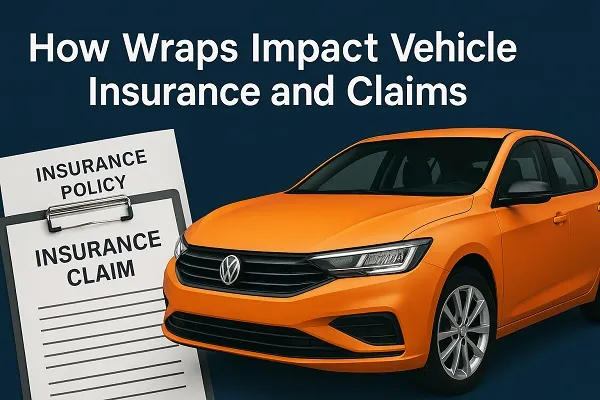Vehicle wraps have become increasingly popular for both personal customization and business branding. While they offer a unique look and potential marketing benefits, many drivers don’t realize that wraps can also affect their vehicle insurance and claims process. Understanding how insurers view wraps, and how they influence coverage and premiums, is crucial before investing in one.
What Is a Vehicle Wrap?
A vehicle wrap is a vinyl covering applied directly to a car’s paint. It can be a full wrap covering the entire vehicle or a partial wrap applied to specific sections. Wraps are often used for:
- Personal customization (color changes, designs, finishes)
- Advertising and business branding
- Paint protection against chips, scratches, and fading
While wraps can enhance appearance and utility, they also change the way insurers assess the value and risk of a vehicle.
How Vehicle Wraps Affect Insurance Coverage
When you add a wrap, you are altering the car’s exterior, which can impact its insured value. Insurance companies may treat a wrap as a custom modification, similar to alloy wheels, custom paint, or body kits.
Insurance Adjustments for Wrapped Vehicles
- Declared Value: You may need to declare the wrap’s cost when setting coverage so the insurer includes it in your policy.
- Premium Adjustments: Some insurers increase premiums slightly to account for modifications, especially if the wrap is expensive.
- Specialized Coverage: Certain providers offer modification coverage that specifically includes wraps and aftermarket changes.
If you don’t inform your insurer about the wrap, you risk losing coverage in the event of an accident.
Impact on Claims Process

Filing a claim with a wrapped vehicle can become more complex than with a standard paint finish.
Collision and Damage Claims
When your wrapped vehicle is damaged in an accident:
- The insurer must decide whether to repair the wrap, replace sections, or pay for a full rewrap.
- If the paint beneath is also damaged, both repairs may need to be coordinated.
- Repairs can take longer since not all repair shops handle vinyl wrap restoration.
Theft and Vandalism Claims
A custom wrap can make your vehicle more recognizable, which may deter theft. However, wraps can also:
- Increase replacement or repair costs if damaged by vandalism.
- Require insurers to carefully assess the cost of reproducing complex designs, especially for business advertising wraps.
Total Loss Claims
If your vehicle is deemed a total loss:
- The wrap’s value may only be reimbursed if it was declared in your policy.
- Without documentation, insurers are unlikely to compensate for the modification.
The Importance of Declaring Vehicle Wraps
Failing to disclose a vehicle wrap to your insurance company can lead to:
- Claim denials if the insurer considers the car “materially altered.”
- Reduced payout since the declared vehicle value does not include the cost of the wrap.
- Policy voidance in extreme cases where non-disclosure is considered misrepresentation.
To avoid complications:
- Always inform your insurer before applying a wrap.
- Provide receipts or invoices for the installation.
- Consider taking photos of the wrap for documentation.
How Wraps Influence Insurance Premiums
Not all insurers view wraps the same way, but several factors influence whether premiums increase:
Factors Insurers Consider
- Cost of the Wrap: Higher-end wraps with specialty materials or custom graphics raise potential claim costs.
- Vehicle Type: A commercial fleet vehicle with branding may face different coverage terms compared to a personal car with a color-change wrap.
- Risk Perception: Some insurers associate modified vehicles with higher accident risk, even if the wrap is cosmetic.
When Premiums Might Stay the Same
- If the wrap is inexpensive and simple, some insurers won’t adjust premiums.
- If you only use the wrap for paint protection (clear or minimal design), insurers may treat it as low risk.
Business Wraps and Commercial Vehicle Insurance

For businesses, wraps are often used as moving billboards. Commercial insurance policies typically treat wraps as company assets.
Key Considerations for Businesses
- Advertising Investment: A damaged wrap with company branding may require a full rewrap to maintain consistency.
- Fleet Insurance: Companies with multiple wrapped vehicles often need higher policy limits.
- Liability: A branded vehicle may draw more scrutiny in accidents, potentially leading to higher liability risks.
Businesses should ensure their commercial auto policies explicitly include wrap coverage.
Steps to Protect Your Wrapped Vehicle
If you’ve invested in a vehicle wrap, take steps to ensure insurance properly covers it.
Best Practices
- Notify Your Insurer: Report the modification immediately.
- Keep Documentation: Save invoices, photos, and installation details.
- Consider Specialized Coverage: Look for insurers experienced with custom vehicles.
- Ask About Wrap Replacement: Confirm whether partial or full replacement is included in claims.
Vehicle wraps add personality, protection, and branding potential, but they also introduce new considerations for insurance and claims. By informing your insurer, keeping proper documentation, and understanding how wraps affect coverage, you can protect both your investment and your peace of mind.

